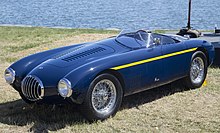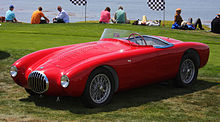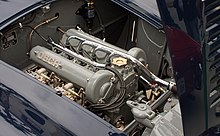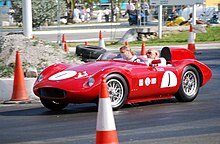
Dino was a marque best known for mid-engined, rear-drive sports cars produced by Ferrari from 1957 to 1976. The marque came into existence in late 1956 with a front-engined Formula Two racer powered by a brand new Dino V6 engine. The name Dino was used for some models with engines smaller than 12 cylinders, it was an attempt by the company to offer a relatively low-cost sports car. The Ferrari name remained reserved for its premium V12 and flat-12 models until 1976, when "Dino" was retired in favour of full Ferrari branding.
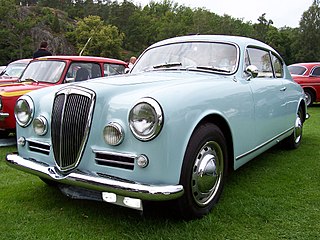
A grand tourer (GT) is a type of car that is designed for high speed and long-distance driving with performance and luxury. The most common format is a front-engine, rear-wheel-drive two-door coupé with either a two-seat or a 2+2 arrangement. Grand tourers are often the coupé derivative of luxury saloons or sedans. Some models, such as the Ferrari 250 GT, Jaguar E-Type, and Aston Martin DB5, are considered classic examples of gran turismo cars.
Vignale is the luxury car sub-brand of Ford Motor Company used in automobiles sold in Europe. The former company Carrozzeria Alfredo Vignale was an Italian automobile coachbuilder established in 1948 at Via Cigliano, Turin, by Alfredo Vignale (1913–69). After its founder's death in 1969, Carrozzeria Vignale was acquired by De Tomaso. The studio ceased operation in 1973, but ownership of the name was taken over by Ford Motor Company.

The Ferrari 250 is a series of sports cars and grand tourers built by Ferrari from 1952 to 1964. The company's most successful early line, the 250 series includes many variants designed for road use or sports car racing. 250 series cars are characterized by their use of a 3.0 L (2,953 cc) Colombo V12 engine designed by Gioacchino Colombo. The 250 series designation refers to this engine's cylinder displacement of approximately 250 cc. They were replaced by the 275 and 330 series cars.
The Ferrari P was a series of Italian sports prototype racing cars produced by Ferrari during the 1960s and early 1970s.
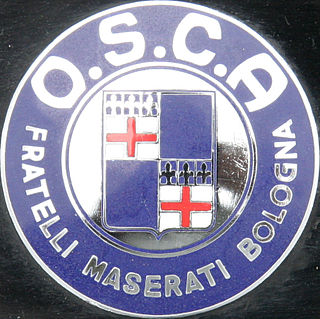
O.S.C.A. was an Italian manufacturer of racing and sports cars established 1947 in San Lazzaro di Savena, Bologna, by the Maserati brothers, and closed down in 1967. The company name is usually written OSCA or Osca.

Maserati A6 were a series of grand tourers, racing sports cars and single seaters made by Maserati of Italy between 1947 and 1956. They were named for Alfieri Maserati and for their straight-six engine.

The Ferrari 250 S was a sports racing car produced by Ferrari in 1952. It was the first in the long lineage of Ferrari 250 road and race cars powered by a ubiquitous 3.0-litre Colombo V12 engine. In 1952 the 250 S won the Mille Miglia and 12 Hours of Pescara. At the Le Mans, the same year, it clocked the fastest race lap time. Only a single example was produced.

The Ferrari 225 S was a sports racing car produced by Ferrari in 1952. It was an evolution over the preceding Ferrari 212 Export with important engine upgrades that greatly improved power output. The model was extensively used in competition, winning many international races. The most important include 1952 Monaco Grand Prix for sports cars, Portuguese Grand Prix, Coppa d'Oro di Sicilia, Coppa della Toscana, Coppa d'Oro delle Dolomiti and many others. It was the final Colombo V12 engine iteration before the 250-family stretched it to 3.0-litres capacity.

The Ferrari Monza is one of a series of cars built by Ferrari. In the early 1950s, Ferrari shifted from using the compact Gioacchino Colombo-designed V12 engine in its smallest class of sports racers to a line of four-cylinder engines designed by Aurelio Lampredi. Inspired by the success of the light and reliable 2.5 L 553 F1 car, the four-cylinder sports racers competed successfully through the late 1950s, culminating with the famed 500 Mondial and 750 Monza.

The Ferrari 212 Export was a sports racing car produced by Ferrari in 1951–1952. The 212 Exports won Tour de France automobile, Giro di Sicilia, Coppa della Toscana, 10 Hours of Messina and other motor races throughout its career. It was meant to be a sports car available for oversea markets.
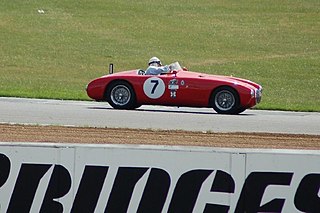
Morelli was an Italian coachbuilder based in Ferrara. Founded by brothers Gino and Nino Morelli, the company was active in the 1950s and the 1960s, building primarily Aluminum bodies for OSCA. Of the 200 cars produced by OSCA, about 80 were MT4 models. Of the MT4 models, 40 Spiders were built by Morelli. All five OSCA FS 372 Spiders were also bodied by Morelli.

The Abarth 205A Berlinetta was a coupé sports car, also known as the Abarth 205A Monza built by Austrian born tuning expert Carlo Abarth in 1950. It was a development of the Abarth Cisitalia 204A but with a new platform chassis, still using the engine and other components from the Fiat 1100 B/E. Only three 205As were finished in 1950; chassis numbers 101, 102, and 103, but an additional car was built in 1953 with an extravagant Ghia body. Slow sales meant that for the next few years Abarth chose to focus on building his exhaust and tuning business, allowing competition and car manufacturing take a backseat. In 1955, the 205A was succeeded by the 207A Spyder and its derivatives.
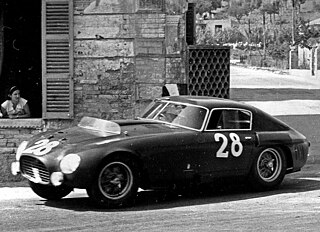
The Ferrari 375 MM, was a sports racing car produced by Ferrari from 1953 to 1955. It was named "375" for the unitary displacement of one cylinder in the 4.5 L V12 engine, and the "MM" stood for the Mille Miglia race. In total 26 units were made, including four converted from the 340 MM.

The Maserati 250S, and its derivative and version, the 250 Sport, are sports racing cars, designed, developed and built by Italian car manufacturer Maserati, between 1954 and 1957. Only two models were produced.

The Ligier JS2 is a mid-engined sports coupé that was built by Ligier in the French commune of Abrest near Vichy in the department of Allier between 1971 and 1975. Road-going and competition versions were built.

The Fiat Pininfarina Cabriolet was a two-door, two passenger, front engine rear drive convertible manufactured by Pinin Farina, and marketed by Fiat across two generations, superseding the Fiat 1200 Spider.
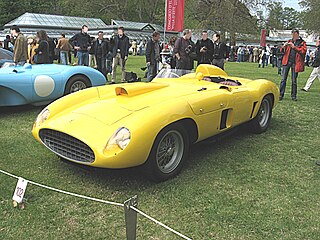
The Ferrari 410 S was a sports racing car produced by Ferrari in 1955–1956. After the racing successes of 375 Plus, mainly in 1954 Carrera Panamericana, Ferrari decided to prepare another model for this marathon. The 410 S was intended as a long-distance race car originally designed for the 1955 Carrera Panamericana and was the final model of the Lampredi V12 sports car lineage. The next generation of sports racing cars that replaced the 410 S were powered by the new Jano V12 engines.

The Ferrari 250 MM was a sports racing car produced by Ferrari from 1952 to 1954. After the initial racing successes of the 3.0-litre Colombo V12 engine, introduced in the 250 S one-off, Ferrari produced a serial racing model. It is best recognisable for the distinctive closed berlinetta bodywork by Pinin Farina. The "MM" in its name stood for the Mille Miglia race.

The Maserati 150 GT was a prototype sports car produced by Maserati in 1957. Derived from the four-cylinder Maserati 150S race car, it was a singular road-going example, and was given spyder bodywork.





